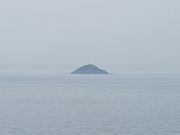
Sivriada
Encyclopedia

Princes' Islands
The Princes' Islands , are a chain of nine islands off the coast of Istanbul, Turkey, in the Sea of Marmara. The islands also constitute the Adalar district of Istanbul Province...
in the Sea of Marmara
Sea of Marmara
The Sea of Marmara , also known as the Sea of Marmora or the Marmara Sea, and in the context of classical antiquity as the Propontis , is the inland sea that connects the Black Sea to the Aegean Sea, thus separating Turkey's Asian and European parts. The Bosphorus strait connects it to the Black...
, near Istanbul
Istanbul
Istanbul , historically known as Byzantium and Constantinople , is the largest city of Turkey. Istanbul metropolitan province had 13.26 million people living in it as of December, 2010, which is 18% of Turkey's population and the 3rd largest metropolitan area in Europe after London and...
.
The island, which has an area of 0.05 km², is officially a neighbourhood in the Adalar district of Istanbul
Istanbul
Istanbul , historically known as Byzantium and Constantinople , is the largest city of Turkey. Istanbul metropolitan province had 13.26 million people living in it as of December, 2010, which is 18% of Turkey's population and the 3rd largest metropolitan area in Europe after London and...
, Turkey
Turkey
Turkey , known officially as the Republic of Turkey , is a Eurasian country located in Western Asia and in East Thrace in Southeastern Europe...
.
Sivriada was often used by the Byzantine
Byzantine Empire
The Byzantine Empire was the Eastern Roman Empire during the periods of Late Antiquity and the Middle Ages, centred on the capital of Constantinople. Known simply as the Roman Empire or Romania to its inhabitants and neighbours, the Empire was the direct continuation of the Ancient Roman State...
clerics as a distant place for peaceful worship, and by the Byzantine emperors as a convenient prison to detain prominent people whom they deemed troublesome. The first famous person to be imprisoned in the island by the order of emperor Nikephoros I
Nikephoros I
Nikephoros I or Nicephorus I, Logothetes or Genikos was Byzantine emperor from 802 to 811, when he was killed in the Battle of Pliska....
was Plato of Sakkoudion, the uncle of renowned cleric Theodoros Stoudites
Theodore the Studite
Theodore the Studite was a Byzantine Greek monk and abbot of the Stoudios monastery in Constantinople. He played a major role in the revivals both of Byzantine monasticism and of classical literary genres in Byzantium...
, for supporting his nephew in his conflict with the emperor. Other famous people who stayed in the island for religious and political reasons were Gebon, Basil Skleros, Nikephoritzes
Nikephoritzes
Nikephoritzes was an influential Byzantine eunuch official, who served as chief minister and virtual ruler of the Byzantine Empire during the reign of Emperor Michael VII Doukas . His actual name was Nikephoros; he received the nickname "Nikephoritzes" as a result of his relative youth when he...
(the chief minister of Michael VII Doukas), Patriarch John of Constantinople and Patriarch Michael II of Constantinople. The graves of those who died in the island during the Byzantine period can still be seen today.
The ruins of a Roman
Roman Empire
The Roman Empire was the post-Republican period of the ancient Roman civilization, characterised by an autocratic form of government and large territorial holdings in Europe and around the Mediterranean....
settlement and a 9th century Byzantine monastery can still be seen on the shore, close to the fishermen's shelter, a small wharf which is often used by yachts. The most important buildings on the island were built in the 9th century AD, including a church, a chapel dedicated to religious martyrs, a monastery on the eastern end (with its walls still seen today) and a cistern in the center of the island (a part of which can still be seen).
In 1911 the governor of Istanbul ordered the stray dogs in the streets to be gathered and deposited to Sivriada, but a severe earthquake which immediately followed the event was perceived as "a punishment by God for abandoning the dogs" and they were transported back to the city.

